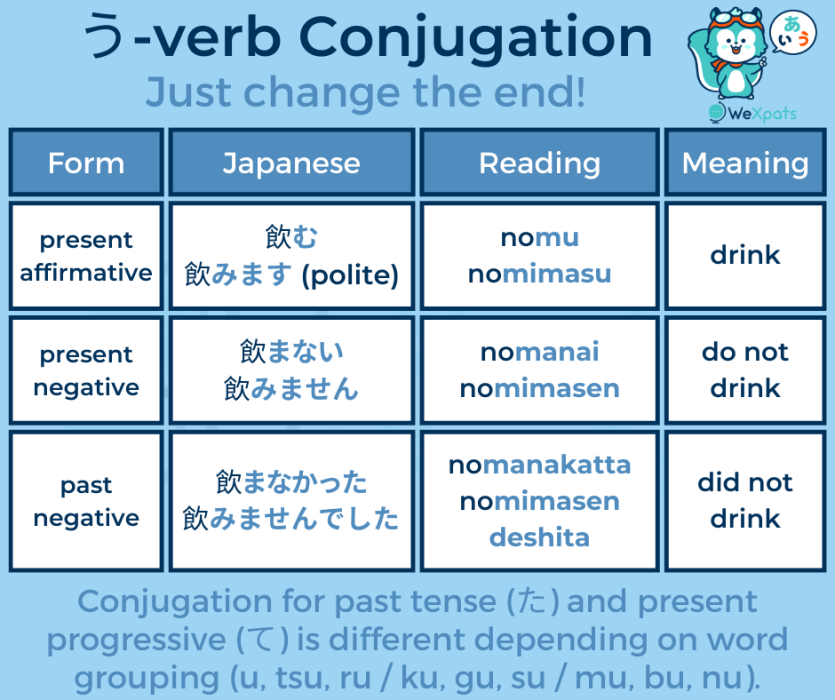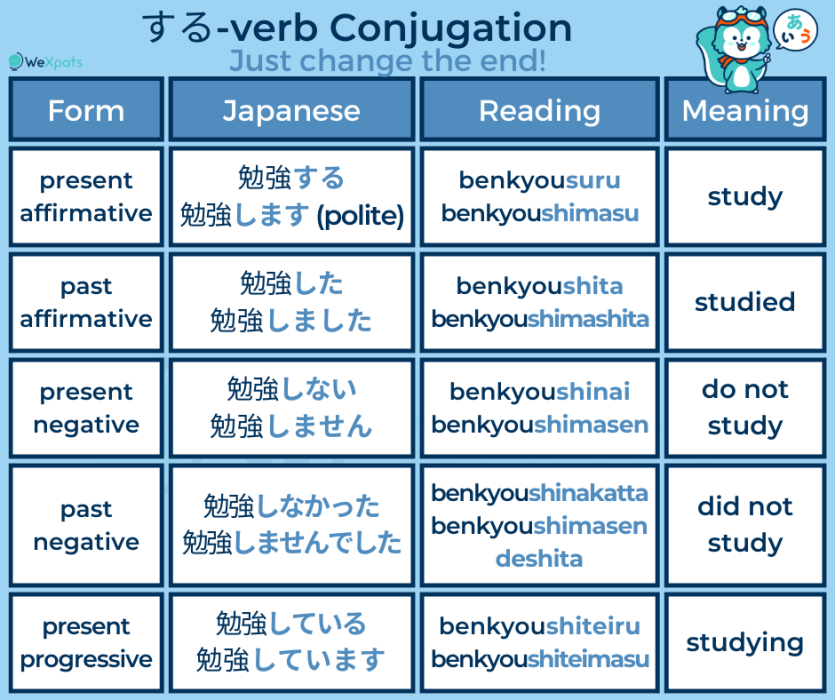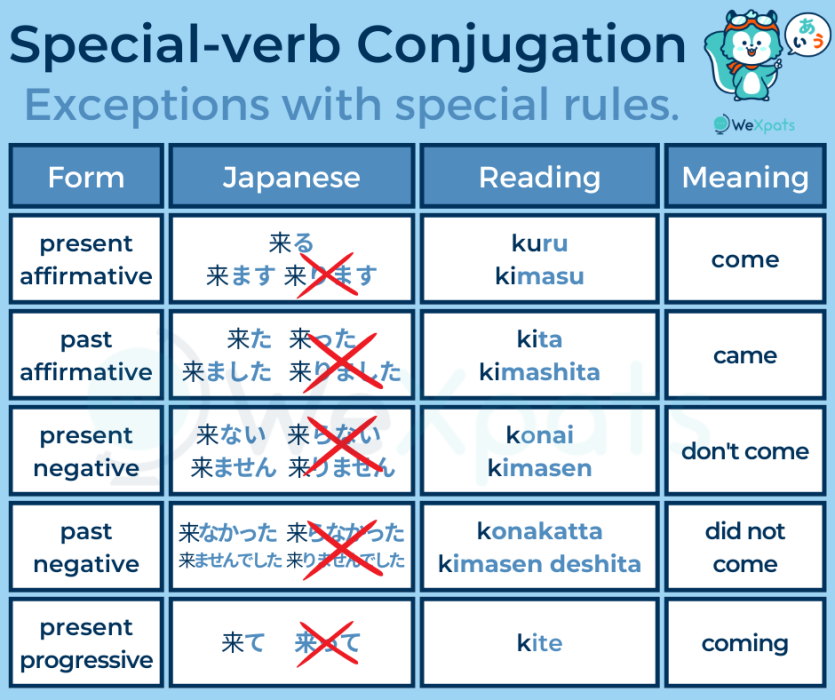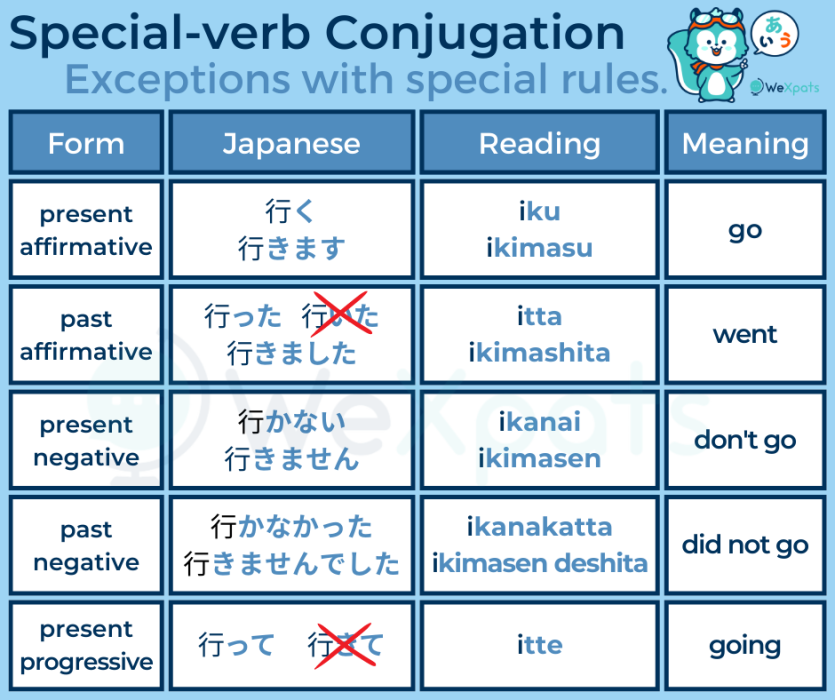Finished studying the basic verbs for the N5 level and how to conjugate the different groups of verbs? Then it’s time to study 225 more Japanese verbs to pass the N4 JLPT!
Table of Contents
Refresh Your Knowledge about Japanese Verbs
Here is a brief recap about Japanese verbs which most people have studied when starting to learn Japanese.
As we stated in our N5 verbs article, Japanese verbs can be categorised into 3 groups, plus the additional 2 irregular verbs 来る (kuru) and 行く (iku).
-
る動詞 (ru-doushi) - verbs that end with る (ru)
-
う動詞 (u-doushi) - verbs that end with う (u)
-
する動詞 (suru-doushi) - nouns that becomes verbs when する (suru) is added to the end
By learning more Japanese verbs, you will be able to have lengthier conversations and expand on your writing in a much more detailed way than the N5 level. You will also need to memorise more kanji characters at this stage.
We have compiled a total of 225 verbs that you are required to know at the N4 level.
Writer's Pick
N4 Ru-verbs

Ru-verbs or る動詞 (ru-doushi) are verbs that end with る (ru).
However, remember that as taught in our N5 verbs article, not all verbs ending with る (ru) are necessarily Ru-verbs. They may be U-verbs depending on the correct method of conjugation.
Here is an example on how to conjugate Ru-verbs. “調べる (shiraberu) - investigate” is a Ru-verb that becomes “調べた (shirabeta) - investigated”; the conjugation rule is simple, just change the end.
At the N4 level, more transitive verbs or 他動詞 (ta-doushi) and intransitive verbs or 自動詞 (ji-doushi) are introduced, and knowing the difference between them is important. The easiest way to differentiate between transitive and intransitive is that transitive is when you/a person/a subject does something, while intransitive is a state of something happening or has happened. Generally, Ru-verbs are transitive verbs, but there are exceptions.
-
他動詞 (ta-doushi) : You / Someone actively performs an action. Is preceded by the を (wo) particle.
-
自動詞 (ji-doushi) : Something (eg. force of nature) performs / performed an action.
For example, “開ける (akeru) - to open” is a transitive verb and a Ru-verb, while “開く (aku) - opens / opened” is an intransitive verb and a U-verb. So, “ドアが開いている (doa ga aiteiru) - the door is open” is very different from “ドアを開けて (doa wo akete) - open the door”.
For how to conjugate Ru-verbs, refer to the chart below. For specific explanations, refer to our N5 verbs article.

N4 Ru-verbs List
Below, we have compiled 58 Ru-verbs that you need to know at this level.
The ones in BOLD are verbs whose kanji characters you need to memorise.
|
あつめる |
集める |
to collect; to assemble; to gather |
|
ふえる |
増える |
to increase; to multiply |
|
はじめる |
始める |
to start; to begin; to commence |
|
ひえる |
冷える |
to grow cold; to cool down |
|
ほめる |
褒める |
to praise; to compliment |
|
いじめる |
苛める |
to bully; to tease; to treat badly |
|
いきる |
生きる |
to live |
|
かえる |
変える |
to change |
|
かんがえる |
考える |
to think; to contemplate |
|
かたづける |
片付ける |
to tidy up; to put in order |
|
きこえる |
聞こえる |
to be heard |
|
きめる |
決める |
to decide; to make up one's mind |
|
こわれる |
壊れる |
broken / breaks; damaged / damages; destroyed / destroys |
|
くらべる |
比べる |
to compare |
|
くれる |
暮れる |
to grow dark |
|
まちがえる |
間違える |
to make a mistake |
|
まける |
負ける |
to lose; to be defeated |
|
みえる |
見える |
to be seen; to be in sight |
|
みつける |
見つける |
to discover; to find (mistake, error, etc.); to come across; to spot |
|
迎える |
迎える |
to go out to meet; to welcome |
|
なげる |
投げる |
to throw away; to fling; to toss away |
|
なれる |
慣れる |
to grow used to; to become familiar with |
|
にげる |
逃げる |
to run away; to escape |
|
にる |
似る |
to resemble; to look alike |
|
のりかえる |
乗り換える |
to transfer (train, bus, etc.); to switch; to change |
|
ぬれる |
濡れる |
to get wet |
|
おちる |
落ちる |
fell / fall; collapsed / collapse; set (sun or moon) |
|
おくれる |
遅れる |
to be late |
|
おれる |
折れる |
broken / breaks; snapped / snaps; folded / folds |
|
さげる |
下げる |
to lower; to bring something down |
|
しらべる |
調べる |
to investigate; to examine |
|
しらせる |
知らせる |
to notify; to inform |
|
しょうじる |
生じる |
to produce; to yield |
|
そだてる |
育てる |
to raise; to rear; to bring up (children, etc.) |
|
すてる |
捨てる |
to throw away; to dispose of |
|
たおれる |
倒れる |
to fall (over, down) |
|
たりる |
足りる |
to be enough; to be sufficient |
|
たてる |
建てる |
to build; to construct |
|
たずねる |
訪ねる |
to visit |
|
たずねる |
尋ねる |
to ask; to inquire |
|
とどける |
届ける |
to send; to deliver |
|
とめる |
止める |
to stop; to turn off |
|
とりかえる |
取り替える |
to replace; to swap; to exchange |
|
つづける |
続ける |
to continue |
|
つかまえる |
捕まえる |
to capture; to arrest |
|
つける |
漬ける |
to dip; to soak; to pickle |
|
つれる |
連れる |
to bring someone along; to be accompanied by |
|
つたえる |
伝える |
to tell; to report |
|
うえる |
植える |
to plant; to grow |
|
うける |
受ける |
to receive; to get; to take (lesson, test, etc.); to undergo (surgery) |
|
わかれる |
別れる |
to separate; to part (people); to break up |
|
われる |
割れる |
to break; to be smashed |
|
やける |
焼ける |
burnt / burns; roasted / roasts; cooked |
|
やせる |
瘦せる |
to become thin; to lose weight |
|
よごれる |
汚れる |
dirtied / dirties; sullied / sullies |
|
ゆれる |
揺れる |
shaken / shakes; swayed / sways |
At the N4 level, beginner learners also start to learn formal Japanese, aka 敬語 (Keigo). It is not necessary to go too deep into Keigo at this level, but if you are interested, please check our Keigo article.
|
もうしあげる |
申し上げる |
to say; to offer; to extend (greetings, congratulations, etc.) (humble) |
|
さしあげる |
差し上げる |
to give; to offer (humble) |
N4 U-verbs

う動詞 (u-doushi) or U-verbs are verbs that end with う (u).
Again, some verbs that end with る (ru) are classified as U-verbs and not Ru-verbs as they follow the U-verb rules of conjugation.
For example, “怒る (okoru) - to get angry” is a U-verb that becomes “怒っている (okotteiru) - is angry”; follows the U-verb conjugation rule for changing to present progressive, る (ru) becomes って (tte).
Transitive and intransitive verbs are separated into Ru-verb and U-verb groups. U-verbs are generally intransitive verbs, but there are exceptions, like “折る (oru) - to break” is a transitive verb despite being of the U-verb, and “折れる (oreru) - broken / breaks” is a intransitive verb despite being a Ru-verb. So, “枝が風で折れた (eda ga kaze de oreta) - the branch was broken by the wind” is very different from “私は枝を折った (watashi wa eda wo otta) - I broke the branch”.
Here are the conjugation charts for U-verbs, including the different rules for past tense and present progressive depending on the verbs ending.



N4 U-verbs List
A compilation of 95 U-verbs that you need to know at the N4 level.
The kanji characters you need to memorise at the N4 level are indicated in BOLD.
|
あがる |
上がる |
raised / rises; went up / goes up; ascended / ascends |
|
あつまる |
集まる |
collected / collects; assembled / assembles ; gathered / gathers |
|
あやまる |
謝る |
to apologize |
|
えらぶ |
選ぶ |
to choose |
|
ふむ |
踏む |
to step on |
|
ふりだす |
降り出す |
to start to rain or snow |
|
ふとる |
太る |
to grow fat; to gain weight |
|
がんばる |
頑張る |
to do one's best |
|
はこぶ |
運ぶ |
to transport; to move |
|
はらう |
払う |
to pay |
|
へる |
減る |
to decrease (in size or number) |
|
ひかる |
光る |
to shine |
|
ひきだす |
引き出す |
to pull out; to withdraw (money) |
|
ひっこす |
引っ越す |
to move house |
|
ひらく |
開く |
to open; to undo; to unseal; to unpack |
|
ひろう |
拾う |
to pick up |
|
いのる |
祈る |
to pray; to wish |
|
いそぐ |
急ぐ |
to hurry; to rush |
|
かまう |
構う |
to mind; to be concerned about |
|
かむ |
噛む |
to bite; to chew |
|
かつ |
勝つ |
to win |
|
かわく |
乾く |
to get dry |
|
かわる |
変わる |
changed / changes; transformed / transforms |
|
かよう |
通う |
to go to (school, work, etc.); to commute |
|
かざる |
飾る |
to decorate |
|
きまる |
決まる |
decided / decides; fixed rule |
|
こむ |
込む |
to be crowded |
|
こわす |
壊す |
to break; to destroy; to damage |
|
もらう |
貰う |
to receive; to accept |
|
まにあう |
間に合う |
to be in time (for) |
|
まわる |
回る |
to go around |
|
みつかる |
見つかる |
found / finds; discovered / discovers |
|
もどる |
戻る |
to turn back |
|
むかう |
向かう |
to go towards |
|
なく |
泣く |
to cry |
|
なくなる |
無くなる |
to be lost; to be missing |
|
なくなる |
亡くなる |
to pass away |
|
なおる |
直る |
to be mended; to be fixed |
|
なおる |
治る |
to recover; to be cured; to be healed |
|
なる |
鳴る |
to make a sound |
|
ねむる |
眠る |
to sleep |
|
のこる |
残る |
to remain; to be leftover |
|
ぬる |
塗る |
to paint |
|
ぬすむ |
盗む |
to steal |
|
おどろく |
驚く |
to be surprised |
|
おどる |
踊る |
to dance |
|
おこなう |
行う |
to perform; to do; to carry out |
|
おこる |
怒る |
to be angry |
|
おこす |
起こす |
to wake up |
|
おくる |
送る |
to send |
|
おもいだす |
思い出す |
to recall; to remember |
|
おもう |
思う |
to think |
|
おる |
折る |
to break; to fold |
|
おとす |
落とす |
to drop |
|
さがる |
下がる |
went down / goes down; came down / comes down |
|
さがす |
探す |
to look for; to find |
|
さそう |
誘う |
to invite |
|
さわぐ |
騒ぐ |
to make noise |
|
さわる |
触る |
to touch |
|
しかる |
𠮟る |
to scold |
|
すべる |
滑る |
to slip |
|
すく |
空く |
to thin out; to get empty |
|
すむ |
済む |
to finish |
|
すすむ |
進む |
to make progress; to advance forward |
|
たのしむ |
楽しむ |
to enjoy; to have fun |
|
たす |
足す |
to add up (numbers); to add (something) |
|
てつだう |
手伝う |
to help; to give a hand |
|
とまる |
泊まる |
to stay at (hotel, etc.) |
|
とおる |
通る |
to go through |
|
つづく |
続く |
continued / continues; go on (weather, etc.); occur again and again |
|
つく |
付く |
attached / attaches; connected / connects; adhered / adheres; stuck / sticks |
|
つる |
釣る |
to fish |
|
つつむ |
包む |
to wrap |
|
うつ |
打つ |
to hit |
|
うつる |
移る |
to move; to transfer |
|
うつす |
写す |
to duplicate; to reproduce; to make a copy |
|
わかす |
沸かす |
to boil; to heat |
|
わく |
沸く |
boiled / boils; grows hot (water, et.c) |
|
わらう |
笑う |
to laugh; to smile |
|
やく |
焼く |
to roast; to bake; to grill; to cook |
|
やくにたつ |
役に立つ |
to be useful; to be helpful |
|
やむ |
止む |
stopped / stops; ceased / ceases; is over |
|
やくす |
訳す |
to translate; to interpret |
|
よろこぶ |
喜ぶ |
to be delighted |
|
よる |
寄る |
to visit; to drop by |
Here, we have the U-verb Keigo. Even if they are Keigo, do not be intimidated, just follow the U-verb rules to conjugate them. For examples of Keigo used in everyday conversations, our Keigo article will come in handy.
|
ごらんになる |
ご覧になる |
to see; to look; to watch (respectful) |
|
いただく |
頂く |
to receive (humble) |
|
いたす |
致す |
to do something (humble) |
|
くださる |
下さる |
to give (respectful) |
|
まいる |
参る |
to go; to come (humble) |
|
めしあがる |
召し上がる |
to eat; to drink (respectful) |
|
もうす |
申す |
to be called; to say (humble) |
|
おいでになる |
お出でになる |
to be; to come; to go (respecful) |
|
おっしゃる |
仰る |
to say (respectful) |
|
うかがう |
伺う |
to visit; to ask (humble) |
N4 Suru-verbs

Suru-verbs or する動詞 (suru-doushi) are nouns that when attached with “する (suru) - to do” to its end becomes a verb.
The chart below shows how to conjugate Suru-verbs which is incredibly easy.

In case you need a recap on how to conjugate irregular verbs 来る (kuru) and 行く(iku), here’s the chart from the N5 article.

N4 Suru-verbs List
Compared to the N5 level, there are a lot more Suru-verbs to learn this time.
Here are 72 new Suru-verbs that you need to know.
|
あいさつ |
挨拶 |
to greet |
|
あんない |
案内 |
to guide |
|
あんしん |
安心 |
to be asssured; to be of peace of mind |
|
アルバイト |
to do a part-time job |
|
|
びっくり |
to be surprised |
|
|
ぼうえき |
貿易 |
to do a trade |
|
チェック |
to check |
|
|
ちゅうい |
注意 |
to caution |
|
ちゅうしゃ |
注射 |
to inject |
|
だんぼう |
暖房 |
to use heating |
|
ダイエット |
to be dieting; to lose weight (by dieting, exercising, etc.) |
|
|
えんりょ |
遠慮 |
to be reserved; to refrain from |
|
ファックス |
to fax |
|
|
ふくしゅう |
復習 |
to review; to do revision |
|
げんいん |
原因 |
to cause |
|
げしゅく |
下宿 |
to lodge |
|
ごちそう |
ご馳走 |
to treat |
|
はいけん |
拝見 |
to see; to look at |
|
はなみ |
花見 |
to do cherry blossom viewing |
|
はんたい |
反対 |
to oppose |
|
はつおん |
発音 |
to pronounce |
|
へんじ |
返事 |
to reply; to answer |
|
ほんやく |
翻訳 |
to translate |
|
ほうそう |
放送 |
to broadcast |
|
いけん |
意見 |
to give an opinion; to comment |
|
じゅんび |
準備 |
to prepare |
|
かいぎ |
会議 |
to have a meeting |
|
かいわ |
会話 |
to converse; to chat |
|
かんけい |
関係 |
to be connected |
|
けが |
怪我 |
to injure |
|
けいかく |
計画 |
to plan |
|
けいけん |
経験 |
to experience |
|
けんぶつ |
見物 |
to sightsee; to visit |
|
けんか |
喧嘩 |
to quarrel |
|
けんきゅう |
研究 |
to research |
|
こしょう |
故障 |
to break-down |
|
こうぎ |
講義 |
to hold a lecture |
|
きょういく |
教育 |
to educate |
|
きょうそう |
競争 |
to compete |
|
きゅうこう |
急行 |
to hurry; to rush |
|
むり |
無理 |
to work too hard; to try too hard |
|
ねぼう |
寝坊 |
to oversleep |
|
にゅうがく |
入学 |
to enroll in school or university |
|
にゅういん |
入院 |
to be hospitalised |
|
おいわい |
お祝い |
to congratulate |
|
れいぼう |
冷房 |
to use the air conditioning |
|
れんらく |
連絡 |
to contact; to get in touch |
|
りよう |
利用 |
to use |
|
るす |
留守 |
to house-sit |
|
せいかつ |
生活 |
to live |
|
せいさん |
生産 |
to produce |
|
せんそう |
戦争 |
to fight; to be at war |
|
せつめい |
説明 |
to explain |
|
しあい |
試合 |
to compete; to be in a match |
|
しっぱい |
失敗 |
to fail |
|
しんぱい |
心配 |
to worry; to be concerned |
|
しょうかい |
紹介 |
to introduce |
|
しゅっぱつ |
出発 |
to depart; to leave; to set off |
|
そつぎょう |
卒業 |
to graduate |
|
そうだん |
相談 |
to discuss |
|
すいえい |
水泳 |
to swim |
|
たいいん |
退院 |
to leave hospital; to be discharged from hospital |
|
たんじょう |
誕生 |
to be born |
|
うんどう |
運動 |
to do physical exercise |
|
うんてん |
運転 |
to drive (a vehicle) |
|
やく |
訳 |
to translate |
|
やくそく |
約束 |
to promise |
|
よしゅう |
予習 |
to prepare for a lesson |
|
よてい |
予定 |
to plan; to make arrangements for; to schedule |
|
ようい |
用意 |
to prepare; to arrange; to get ready; to lay out |
|
よやく |
予約 |
to book; to reserve |





































